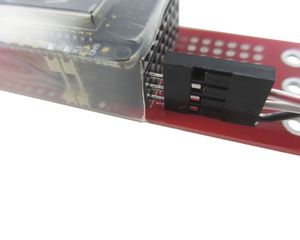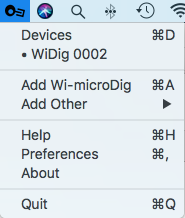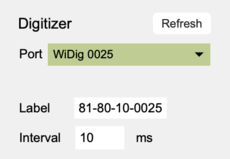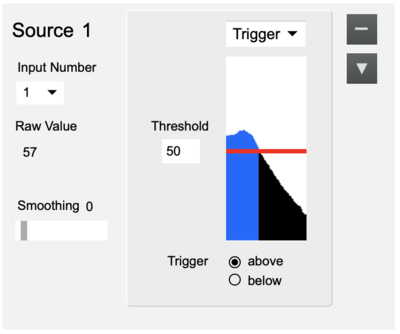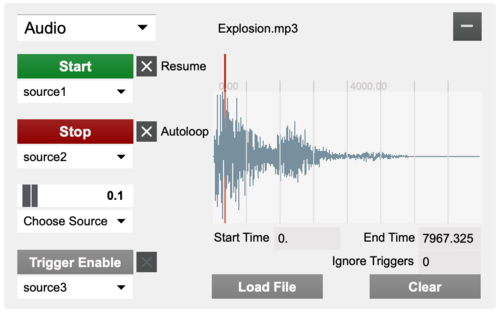SensePlay-10 QuickStart WiDig USB
What you need
For this walkthrough, you will need:
- A WiDig and its drivers (see below).
- A Turn (or other) sensor for testing.
- SensePlay software.
- Connect software (included in the SensePlay software package).
- SiliconLabs driver
- LoopMIDI (Windows only)
Installing the WiDig
The WiDig is pre-configured to communicate via Bluetooth, even though it can still communicate via USB but at MIDI data rate of 31.25 kbps. If you'd like to be able to set the WiDig to communicate via USB only, at the higher data rate of 115.2 kbps, connect with EditorX to the WiDig.
On both Windows and MacOS, to communicate via USB, you'll first need to add the WiDig as a virtual serial (or COM) port by installing its SiliconLabs driver. If your operating system is not the most recent version, you may need to install an older driver.
On MacOS, the drivers were installed correctly if the connected WiDig is listed in System Report (under About this Mac), in the USB section under Hardware. There should be an entry "CP2104 USB to UART Bridge Controller".
On Windows, the drivers were installed correctly if the WiDig is listed in the Device Manager (select from the menu that appears after right-clicking on the Start menu) as a serial port with name "COM..".
On MacOS Sierra or higher, make sure to allow the driver extension in the "Security & Privacy" panel of the System Preferences, within 30 minutes after installation (or else re-install the drivers if MacOS doesn't show a way to allow the driver).
On Windows, LoopMIDI virtual MIDI port software needs to be installed as well. There's no need to create any ports in LoopMIDI, nor does the LoopMIDI system tray app need to be running.
Connecting to the WiDig
1. Connect the Turn sensor (or any other sensor) to input #1 of the WiDig as shown below, with the red wire on top and the black wire on the bottom.
2. Start Connect. On MacOS it may be necessary to add a security exception in order to open it. On Windows Connect must be running before starting EditorX in order for EditorX to recognize the MIDI port(s) that Connect creates.
If you're using a computer with Apple's M1 processor, you'll need to run SensePlay under Rosetta as follows:
- Click the SensePlay icon in the Finder.
- Click the File menu in the Finder and choose the option "Get Info".
- In the Get Info window, tick the checkbox next to "Open using Rosetta".
- Close the Get Info window.
3. On MacOS, click on the Connect icon in the menu bar. The WiDig entry with matching serial number should be listed in Connect's menu, with a dot in front of its name. If not, click Refresh Devices on the menu. If Connect still wasn't successful in communicating with the WiDig and the device's setting aren't shown in Connect, keep the WiDig plugged in and try quitting Connect, then pressing the button next to the blue LED of the WiDig and then restarting Connect.
On Windows, right-click on the Connect icon in the system tray. The WiDig entry with matching serial number should be listed in Connect's menu.
On either MacOS or Windows, click on the WiDig entry to open the digitizer view to further inspect the WiDig's status.
4. Start SensePlay. On MacOS it may be necessary to add a security exception in order to open it. Note that on MacOS, the next time you run SensePlay and Connect isn't already running, Connect should be started automatically when starting SensePlay.
5. In the Digitizer section at the top, choose the WiDig with matching serial number. Upon connecting, the port menu will turn green. If SensePlay failed to connect to the WiDig, maybe the Connecting section on the Digitizer page can help you resolve the issue.
6. Click the "+" button on the left to add a new source, then select "1" from the Input Number menu to turn on sampling of sensor input 1. The box right below the button and the graphical display will show the sensor value if changed.
7. Click the "+" button on the right to add a new output, then drag a sound file into it. Select "Source1" from the pull-down menu below the Start button to allow the Start button to be triggered by the source. Make the sensor output a value that crosses the threshold set in the source and the sound file should start to play.
8. You're up and running. For further details about using SensePlay, refer to the SensePlay help pages.
